
views
Selecting the Parent Fish
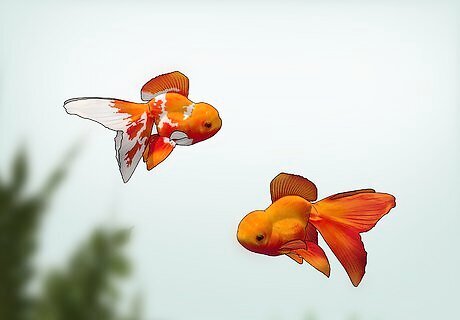
Pick out a healthy adult fish of each sex. In order to breed fish, your first step is to determine their biological sex. Unlike some other animals, this will be trickier than looking for differences in their genitalia. The biological differences between species can vary greatly, but there are a few common traits to look for. Female Cichlids, for example, tend to have rounded bodies and less pronounced vents, while males usually display more vibrant coloration and sometimes have a small hump on their heads. Make sure you only breed fish of the same species. While it may be possible for two different species to reproduce, there’s a good chance that the resulting hybrid will be feeble, deformed, or sterile. Pass over fish that appear sick, injured, or deformed. They’re less likely to produce healthy offspring. If you're at a loss for how to differentiate the sex of your fish, take them to an aquatic veterinarian or breeding specialist to have them examined by an expert.
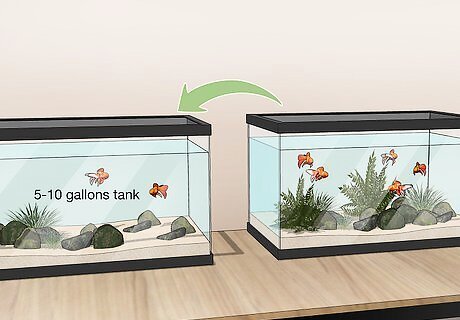
Place the parent fish together in a separate tank. This tank is often known as a “spawning tank.” Isolating the parent fish in a spawning tank shrinks the mating pool to 2, making them more likely to couple than they may be otherwise. It also allows you to tinker with the conditions inside the tank without being disruptive to a larger colony of non-mating fish. For most species of fish, you’ll need a spawning tank with a capacity of at least 5–10 gallons (19–38 l). When you first transplant the parent fish to a new tank, it's best to keep the conditions as close to their old tank as possible and make necessary adjustments very gradually to help them get acclimated.

Condition the fish to make them more robust. Feed the parent fish a nutrient-rich, high protein diet while you’re encouraging them to mate. Proper nutrition will help them flourish and increase their fertility. Remember: the healthier the parents are, the healthier the babies will be. Most average-sized aquarium species like Bettas and Angelfish prefer a live diet of fresh or frozen brine shrimp, white worms, or daphnia. It’s best to condition fish for roughly 2 weeks before they begin mating. Learn about your parent species’ natural diet to know what sorts of foods you should be feeding them in the early phases of breeding. Most fish do best with a balance of fresh herbaceous plants, as well as live offering like brine shrimp.
Creating Favorable Mating Conditions
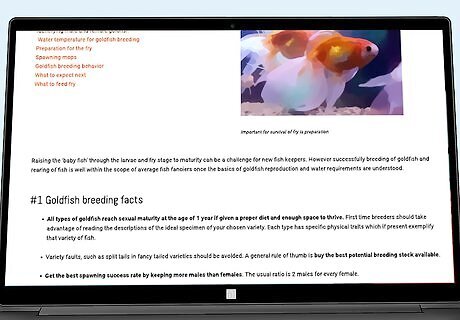
Research the mating habits of the fish you’re attempting to breed. Before you attempt to put 2 fish of the opposite sex together, make an effort to learn about their instinctive reproductive behaviors. Knowing what a particular species looks for in a mate and how they lay their eggs, as well as the exact manner in which they copulate, will allow you to closely mimic breeding conditions in the wild. Read up on your species in a fish encyclopedia. You may also be able to find books and manuals that delve deeper into the specifics of aquarium breeding.
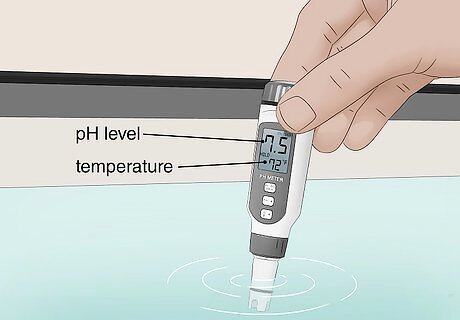
Optimize the conditions of the water in the tank. Apply your newfound knowledge of your parent species to make their surroundings more hospitable. Factors like temperature and the chemical and mineral balance of water can influence whether or not fish decide to mate. It may be necessary to use a separate heating element to warm the tank or soften the water to change its basic composition. In order for Discus and related species to begin breeding, the water in the tank must be brought to between 82–88 °F (28–31 °C), with a pH level of 6-7 and moderate to low light. Goldfish breed in spring. Lower the water temperature to 52 °F (11 °C). Then, when you are ready to breed them, gradually raise it 3 °F (1.7 °C) per day until it reaches 72 °F (22 °C). If you have to make a significant adjustment to the water in the spawning tank, do it little by little. Water temperature, for instance, should only be raised or lowered 3-5 degrees over the course of about a week. Too drastic a change in too short a time may agitate or even harm the parent fish.
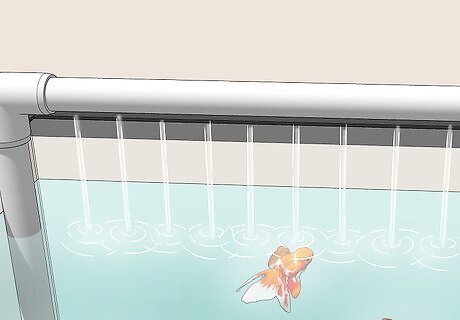
Simulate the rainy mating season. This is when most fish begin to breed in the highest numbers. Use a watering can or circulating sprayer system to create the effect of a light downpour on the surface of the water. Changing the water level by draining the tank halfway and slowly refilling it can also trick fish into thinking that it’s the ideal time to fertilize and lay eggs. When you first lower the water level in the tank, leave it shallow for a few days so that the fish have time to get used to the difference. Then, gradually return the water to its original level over the course of about a week, using water that’s 2–3 °F (−17 – −16 °C) cooler than what’s already in the tank. For a more convincing simulation, try dimming the lights in the room and switching a flashlight on and off near the tank to make “lightning.”
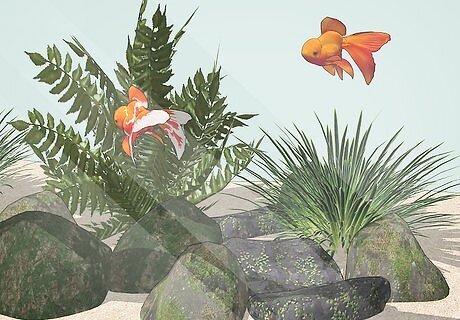
Incorporate familiar physical features. Add elements like stones, plants, and artificial tunnel structures to the tank to approximate the natural conditions under which the parent fish prefer to mate. Cichlids, for example, typically mate on flat rocks, while other species retreat to the safety of caves or drift closer to the surface of the water. A more recognizable environment will put them at ease and prompt them to increase their numbers. Constructing the ideal physical environment for breeding to take place will largely be a matter of knowing how the fish choose a mate and lay their eggs. These structures will also provide a place for the female fish to deposit her eggs.
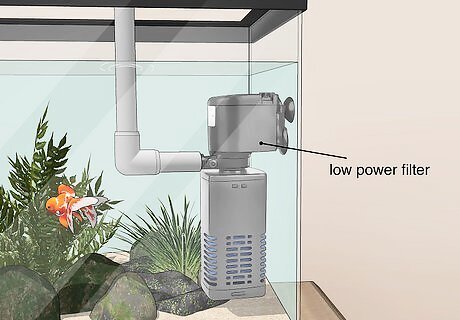
Outfit the tank with a low-power filter. If necessary, switch out the filter you currently have in your spawning tank for one with less suction. High-speed filters may over-circulate the water, creating strong currents that can sweep away tiny eggs or even suck them up. Sponge filters are typically recommended for aquarium breeding. Using a less powerful filter may make it necessary to clean or replace the water in the tank more frequently (up to 15-20% of the total volume every 1-2 weeks, depending on how murky it is).
Protecting and Caring for the Fry

Remove the parent fish from the spawning tank. Once the female has laid her eggs or given live birth, return both parents to their original tank, where they will quickly acclimate to their ordinary environmental conditions. This will protect the eggs from being interfered with long enough for the fry (newborn fish) to hatch. Keep the conditions in the tank the same. It can now be used as a nursery tank to rear the fry. With the exception of a few nurturing species, it’s not uncommon for adult fish to devour their own eggs. If it’s not possible to set up a different tank for the fry, add an abundance of plants and other physical structures to give them a place to hide once they’re capable of swimming.
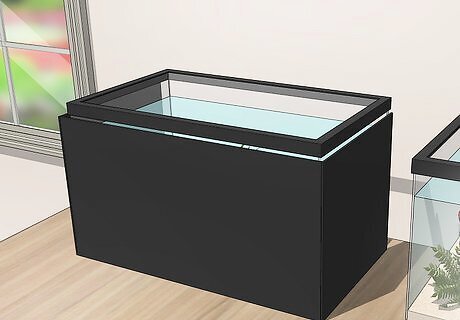
Limit the amount of light that enters the tank. Cover the tank on 3 sides with paper or scraps of fabric thick enough to block out most of the light from outside. Eggs and newly-hatched fish are often sensitive to light—too much may stunt their development or even kill them. As they continue to grow, their tolerance will increase and you can return the aquarium to its original light levels. Be sure to black out the sides that receive the most direct light exposure. Leave one of the larger sides uncovered for observation. You can even leave the tank completely covered with a sheet when you’re not feeding or checking on the fry.
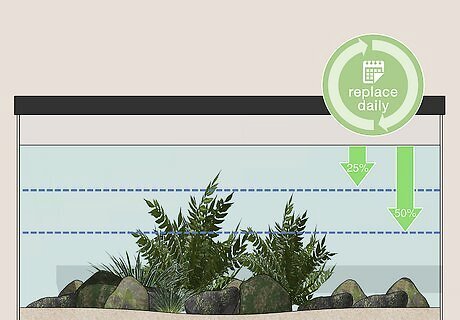
Change the tank water daily. Get in the habit of emptying the tank by 25-50% and replacing it with fresh water at the same time each day. Clean water is a must while the fry are learning to breathe and filter on their own. Draw from the same source every time you refill the tank. It’s important that the new water have the same basic composition as the old.

Feed the young fish several times a day. When the fry first hatch, they come equipped with a large yellow egg sac that provides sustenance for a few days. Once this egg sac disappears, you’ll need to begin feeding them yourself. Liquid egg yolks, crushed fish flakes, plankton and algae are all examples of foods used to nourish fry. Look for the foods and supplements you need at pet stores that sell specialty fish supplies. As always, do your homework to find out what foods are suitable for the fry of the species you’ve selected for breeding. Smaller species like tetras and rainbowfish, for example, won't be able to handle commercially prepared foods so soon after hatching, and need to be fed liquid infusoria or similar supplements that they can digest easily. As the fry grow larger, they can graduate to more substantial live foods like brine shrimp and microworms.




















Comments
0 comment